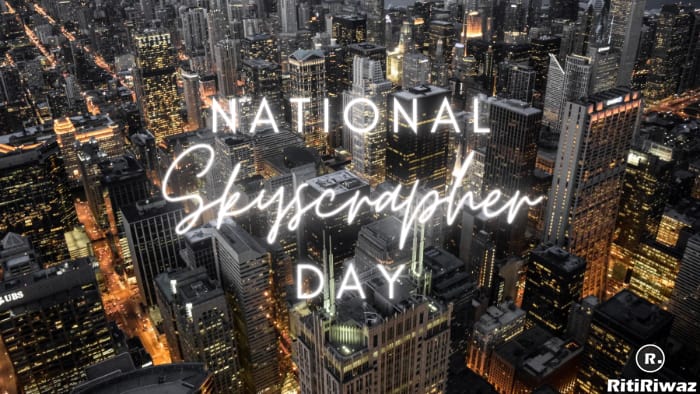National Skyscraper Day

National Skyscraper Day is celebrated on 3rd September every year to appreciate and admire the world’s tallest skyscrapers. It is celebrated to commemorate the birthday of architectural forefather Louis H. Sullivan (September 3, 1856), the “father of skyscrapers” the architect credited with building the first skyscrapers. Sullivan’s influence set in motion some of the most important ideas in modern architecture.
Skyscrapers are truly engineering and architectural marvels. In many crowded cities, space is in short supply, and real estate prices are ever-increasing. Building “up” becomes more and more logical. As technical capabilities in construction improved, skyscraper buildings have become taller and taller. In addition, there is a certain prestige to have one of the tallest buildings in the world in your city and country.
Historically, the world’s tallest man-made structure was the Great Pyramid of Giza in Egypt, which held the position for over 3,800 years, until the construction of Lincoln Cathedral in England in 1311. The early skyscraper was pioneered in Chicago with the 138 ft (42.1 m) Home Insurance Building in 1885, forming the basis for which the United States would hold the position of the world’s tallest building throughout the 20th century.
While Skyscraper construction and design have remained largely unchanged over the last century, several aspects of construction are due for radical changes to increase efficiency and improve sustainability. The three tallest buildings in the world are the Burj Khalifa in Dubai, the Shanghai Tower in mainland China, and the Makkah Royal Clock Tower in Mecca. They stand as symbols of economic prosperity in their respective cities.
The Burj Khalifa is so high that its highest point is 2,717 feet above the ground. This is as tall as some mountains, allowing it to touch the clouds. These structures dominate the cityscape and can be seen from miles away. Those who want to make a strong statement will find no better way to do it. The number of buildings that exceed 200 meters or 656 feet in height has tripled since the year 2000. It seems like everyone wants to touch the sky.
World 10 famous skyscrapers
To celebrate Skyscraper Day, we’ve rounded up the ten tallest skyscrapers around the world, which vary from the famous Burj Khalifa in Dubai, and the all-new One World Trade Center in New York
1. Burj Khalifa, Dubai
Since its completion in 2010, Burj Khalifa—in the heart of downtown Dubai, claims to be the world’s tallest skyscraper. It stands at 2,717 feet tall and has 163 floors. The building is an example of international cooperation as Skidmore, Owings & Merrill of Chicago designed it, and Samsung C&T of South Korea was responsible for the engineering and construction.
Suggested Read: Dubai Travel
2. Shanghai Tower, Shanghai
Shanghai Tower was completed in March 2014 after eight years of construction. It cost $4.2 billion, is 2,073 feet tall, and has 121 floors. The tower is one of three super-tall skyscrapers in the heart of Shanghai’s Lujiazui financial district.
3. Makkah Royal Clock Tower, Mecca
Also known as Abraj Al Bait, the Makkah Royal Clock Tower Hotel is a government-owned building complex in Mecca, Saudi Arabia. Saudi Binladin Group, Saudi Arabia’s largest construction company, built the complex. German architect Mahmoud Bodo Rasch and his firm SL Rasch GmbH designed the clock tower. The dimensions of the clock face at the very top are 141 feet by 141 feet, making it the largest in the world.
4. Ping An Finance Center, Shenzhen
Ping An Finance Center, a 599-meter (1965-foot) skyscraper in Shenzhen is now officially China’s second tallest building and the world fourth-tallest building. Developed by Ping An Finance Center Construction & Development, the supertall structure was designed to prove its iconic presence for China’s second-largest insurance company and a centerpiece to the burgeoning city of Shenzhen.
5. Lotte World Tower, Seoul
The Lotte World Tower is the tallest building in South Korea and the fifth tallest building in the world. The tower’s sleek design pales in comparison to its record-shattering features, which include the world’s highest glass-bottomed observation deck and the world’s fastest elevator.
6. One World Trade Center, New York
After 9/11, a new World Trade Center was designed to become a statement, an emotional reaction, and the centerpiece of the New York skyline. One World Trade Center currently stands at 1,776 feet tall and is the tallest building in the U.S.
7. Guangzhou CTF Finance Center, Guangzhou
Construction for the 112-story Chow Tai Fook Finance Centre began in 2010, and the estimated completion date is in 2016. The architecture firm Kohn Pedersen Fox Associates is creating the building on behalf of Chow Tai Fook Enterprises. The building has already topped out at 1,739 feet and is located in Guangzhou’s Tianhe District.
8. Tianjin CTF Finance Center, Tianjin
Tianjin CTF Finance Centre become the world’s eighth-tallest building, at 530 meters. The tower has a striking silhouette, defined by a series of curves that converge at an open-lattice crown. A glass facade sheaths the sinuous form of the skyscraper, making a dramatic impression as it reflects the sky.
9. China Zun, Beijing
Located at the core of Beijing’s new 30-hectare central business district, CITIC Tower is the tallest building and a new icon of the capital. The tower’s gently rising and curving form resembles an ancient Chinese ceremonial vessel, called the “ZUN.” The design concept is that of a transforming shell that gradually bends to create a dramatic form.
10. Willis Tower, Chicago
Willis Tower was originally known as the Sears Tower, was the world’s tallest building for 23 years until it was unseated in 1996 by the Petronas Twin Towers in Kuala Lumpur. The 110-story skyscraper is still mighty impressive. Its “bundled tube” design by architectural firm Skidmore, Owings & Merrill was originally inspired by a handful of cigarettes and the innovative bundling changed the construction of supertall, wind-resistant buildings thereafter.
Top three reasons to visit the tallest skyscrapers:
Architectural race: The architectural race to see which country can build the tallest skyscraper still charges on and there doesn’t seem to be an end in sight. Each time a new skyscraper tops the list, it’s pushing the limits for how tall a building can be built. There are many reasons why the record is tough to beat. Money and the elevator system seem to be two of the toughest challenges. This gives yet another reason to marvel at these architectural feats.
Location: The world’s tallest skyscrapers are built in some of the most interesting cities with much more to see and do. For example, if you’re visiting One World Trade Center in New York City, you’ll have the opportunity to take in all the sites the city offers. Central Park and Broadway shows are just a few.
Art and history: Just to name a few U.S. examples, the Empire State Building was the tallest building in the world for more than 40 years, making it historically significant. It’s also a premier example of Art Deco architectural design, which was popular in 1929 when it was erected. One World Trade Center is said to be one of the greenest and safest skyscrapers ever built.
It is the day of the year set aside for us to pay homage to the engineering wonders of the world known as skyscrapers. Have a fun-filled celebration with skyscrapers by enjoying the sights from the top of a skyscraper.
You can enjoy the day by:
- Taking pictures of skyscrapers.
- Entering an elevator in a skyscraper building.
- Reading a book on skyscrapers.
- Painting a skyscraper.
- Designing skyscrapers.
- and many more.
What is your favorite skyscraper?
Suggested Read: Important Days In September






